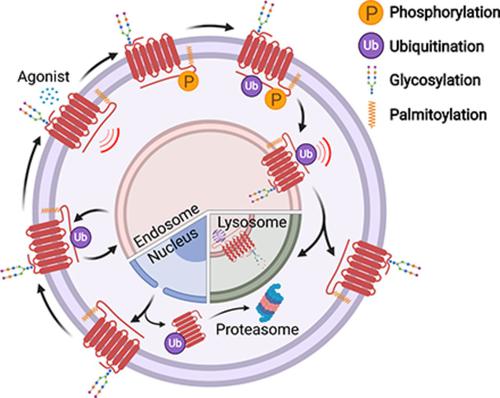当前位置:
X-MOL 学术
›
Pharmacol. Rev.
›
论文详情
Our official English website, www.x-mol.net, welcomes your
feedback! (Note: you will need to create a separate account there.)
Post-Translational Modifications of G Protein–Coupled Receptors Control Cellular Signaling Dynamics in Space and Time
Pharmacological Reviews ( IF 19.3 ) Pub Date : 2021-01-01 , DOI: 10.1124/pharmrev.120.000082 Anand Patwardhan 1 , Norton Cheng 1 , JoAnn Trejo 2
Pharmacological Reviews ( IF 19.3 ) Pub Date : 2021-01-01 , DOI: 10.1124/pharmrev.120.000082 Anand Patwardhan 1 , Norton Cheng 1 , JoAnn Trejo 2
Affiliation

|
G protein–coupled receptors (GPCRs) are a large family comprising >800 signaling receptors that regulate numerous cellular and physiologic responses. GPCRs have been implicated in numerous diseases and represent the largest class of drug targets. Although advances in GPCR structure and pharmacology have improved drug discovery, the regulation of GPCR function by diverse post-translational modifications (PTMs) has received minimal attention. Over 200 PTMs are known to exist in mammalian cells, yet only a few have been reported for GPCRs. Early studies revealed phosphorylation as a major regulator of GPCR signaling, whereas later reports implicated a function for ubiquitination, glycosylation, and palmitoylation in GPCR biology. Although our knowledge of GPCR phosphorylation is extensive, our knowledge of the modifying enzymes, regulation, and function of other GPCR PTMs is limited. In this review we provide a comprehensive overview of GPCR post-translational modifications with a greater focus on new discoveries. We discuss the subcellular location and regulatory mechanisms that control post-translational modifications of GPCRs. The functional implications of newly discovered GPCR PTMs on receptor folding, biosynthesis, endocytic trafficking, dimerization, compartmentalized signaling, and biased signaling are also provided. Methods to detect and study GPCR PTMs as well as PTM crosstalk are further highlighted. Finally, we conclude with a discussion of the implications of GPCR PTMs in human disease and their importance for drug discovery.
中文翻译:

G 蛋白偶联受体的翻译后修饰控制空间和时间上的细胞信号传导动力学
G 蛋白偶联受体 (GPCR) 是一个由 >800 信号传导受体组成的大家族,可调节多种细胞和生理反应。 GPCR 与多种疾病有关,是最大的一类药物靶点。尽管 GPCR 结构和药理学的进步改善了药物发现,但通过多种翻译后修饰 (PTM) 对 GPCR 功能的调节却很少受到关注。已知哺乳动物细胞中存在超过 200 个 PTM,但仅报道了少数几个与 GPCR 相关的 PTM。早期研究揭示磷酸化是 GPCR 信号转导的主要调节因子,而后来的研究表明 GPCR 生物学中具有泛素化、糖基化和棕榈酰化功能。尽管我们对 GPCR 磷酸化的了解非常广泛,但我们对其他 GPCR PTM 的修饰酶、调控和功能的了解有限。在这篇综述中,我们对 GPCR 翻译后修饰进行了全面概述,重点关注新发现。我们讨论了控制 GPCR 翻译后修饰的亚细胞定位和调控机制。还提供了新发现的 GPCR PTM 对受体折叠、生物合成、内吞运输、二聚化、区室化信号传导和偏向信号传导的功能影响。进一步强调了检测和研究 GPCR PTM 以及 PTM 串扰的方法。最后,我们讨论了 GPCR PTM 在人类疾病中的影响及其对药物发现的重要性。
更新日期:2020-12-02
中文翻译:

G 蛋白偶联受体的翻译后修饰控制空间和时间上的细胞信号传导动力学
G 蛋白偶联受体 (GPCR) 是一个由 >800 信号传导受体组成的大家族,可调节多种细胞和生理反应。 GPCR 与多种疾病有关,是最大的一类药物靶点。尽管 GPCR 结构和药理学的进步改善了药物发现,但通过多种翻译后修饰 (PTM) 对 GPCR 功能的调节却很少受到关注。已知哺乳动物细胞中存在超过 200 个 PTM,但仅报道了少数几个与 GPCR 相关的 PTM。早期研究揭示磷酸化是 GPCR 信号转导的主要调节因子,而后来的研究表明 GPCR 生物学中具有泛素化、糖基化和棕榈酰化功能。尽管我们对 GPCR 磷酸化的了解非常广泛,但我们对其他 GPCR PTM 的修饰酶、调控和功能的了解有限。在这篇综述中,我们对 GPCR 翻译后修饰进行了全面概述,重点关注新发现。我们讨论了控制 GPCR 翻译后修饰的亚细胞定位和调控机制。还提供了新发现的 GPCR PTM 对受体折叠、生物合成、内吞运输、二聚化、区室化信号传导和偏向信号传导的功能影响。进一步强调了检测和研究 GPCR PTM 以及 PTM 串扰的方法。最后,我们讨论了 GPCR PTM 在人类疾病中的影响及其对药物发现的重要性。











































 京公网安备 11010802027423号
京公网安备 11010802027423号